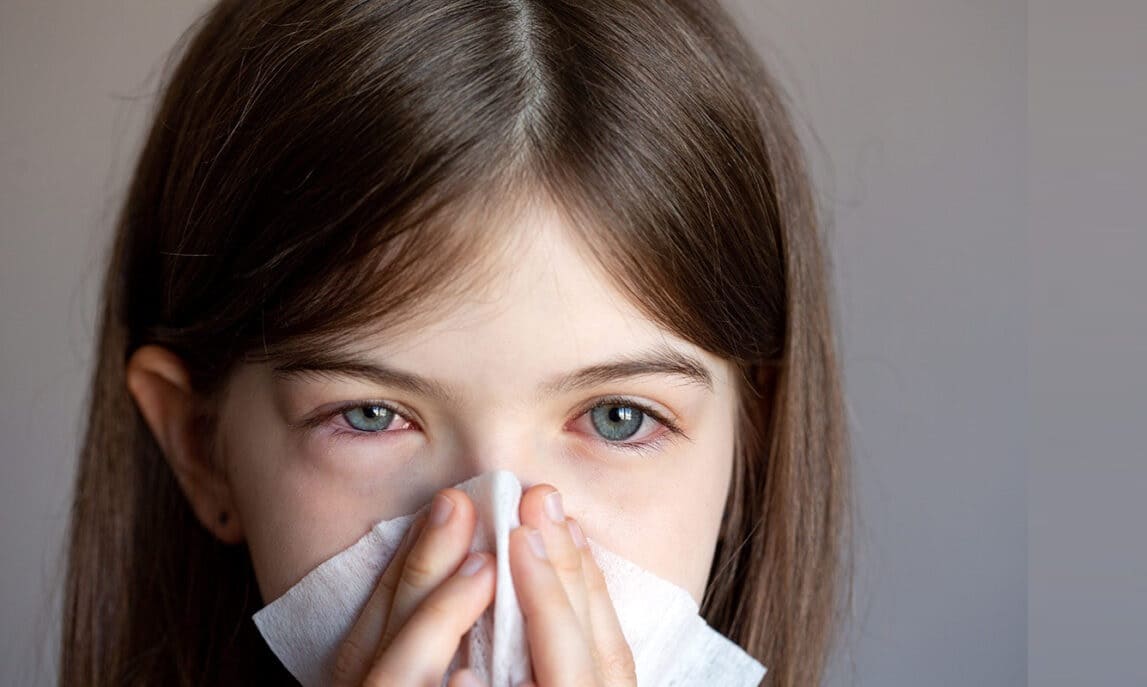Allergic Conjunctivitis : A Complete Overview with Treatment 2025

Allergic conjunctivitis is one of the most common eye conditions caused by an allergic reaction. It affects millions of people worldwide and can significantly impact the quality of life if left untreated. This comprehensive guide will provide a complete overview of allergic conjunctivitis, including its symptoms, causes, diagnosis, treatment options, and tips for prevention and management.
What is Allergic Conjunctivitis?
Allergic conjunctivitis refers to inflammation of the conjunctiva (the thin transparent layer that covers the white part of the eye) due to an allergic reaction. It is caused by the immune system’s overreaction to substances in the environment that normally do not cause issues, called allergens.
When allergens like pollen, pet dander, dust mites, mold, or makeup come into contact with the eyes, they trigger the release of antibodies called immunoglobulin E (IgE). The IgE antibodies then cause the release of histamines and other chemicals that irritate the eyes and stimulate inflammation as part of the allergic response.
Symptoms of Allergic Conjunctivitis
The most common symptoms of allergic conjunctivitis include:
- Itchy eyes – Itchiness is usually the first and most irritating symptom. It can range from mild to severe.
- Watery eyes – Excessive tearing and watery discharge are common as the eyes try to flush out allergens.
- Redness – Blood vessels on the surface of the eye become noticeably inflamed and irritated.
- Burning or stinging – Some patients experience a painful, burning sensation in the eyes.
- Eyelid swelling – The eyelids may become puffy and swollen due to inflammation.
- Sensitive to light – Discomfort when exposed to bright lights.
- Blurred vision – Fluid in the eye can temporarily affect visual acuity.
- Dark circles under the eyes – Allergies can lead to a lack of sleep, causing dark undereye circles.
- Crusting of eyelashes – Allergic discharge can dry and form crusts around the lashes.
The severity of symptoms can vary from mild irritation to intense itching, redness, and swelling that interfere with daily activities. Symptoms typically affect both eyes.
Causes and Triggers of Allergic Conjunctivitis
Allergic conjunctivitis is caused by an IgE-mediated allergic response to specific allergens that come into contact with the surface of the eye. Common triggers and risk factors include:
Seasonal Allergies
- Pollen – Tree pollen in spring, grass pollen in summer, weed pollen in fall.
- Mold spores – Higher levels during hot, humid weather.
Perennial Allergies
- Dust mites – Microscopic bugs in dust trigger year-round symptoms.
- Pet dander – Skin flakes, saliva, and urine from cats, dogs, birds, and other pets.
- Cosmetics & makeup – Mascara, eye shadow, eyeliner, cleansers, eye cream.
- Perfumes – Fragrances and essential oils can irritate the eyes.
- Eyedrops & medication – Preservatives like benzalkonium chloride.
- Contact lens solution
- Laundry detergent – Residues on clothes worn close to the face.
- Pollution – Smog, fumes, chemicals.
- Smoke – From cigarettes, fires, wood-burning stoves.
- Swimming pools & hot tubs – Chlorine and other chemicals in the water.
Other Causes
- Eye infections – Bacterial or viral conjunctivitis makes the eyes more vulnerable to allergens.
- Eye injuries/surgeries
- Blepharitis – Inflammation of the eyelids.
- Atopic dermatitis/eczema – Chronic skin condition linked to increased allergy risk.
- Allergic rhinitis – Hay fever and nasal allergies, since nasal and eye symptoms often go together.
- Family history – Higher risk if parents or siblings have allergies.
Diagnosing Allergic Conjunctivitis
An eye doctor can diagnose allergic conjunctivitis through a medical history, eye examination, and certain tests. Key aspects include:
- Medical history – The doctor asks about symptoms, exposure to triggers, and family history of allergies. Timing and length of symptoms provide clues.
- Slit lamp exam – Allows close inspection of swelling, redness, discharge, and other signs of inflammation on the eye’s surface.
- Vision test – Checks if allergy symptoms are affecting visual acuity.
- Allergy testing – Skin prick testing for common environmental allergens can confirm specific triggers. Blood tests check for allergen-specific IgE antibodies.
- Conjunctival scraping – Microscopic examination of eye discharge can rule out viral or bacterial conjunctivitis.
- Eyelid examination – Swollen, inflamed lids may indicate blepharitis contributing to allergy symptoms.
Proper diagnosis is important since other conditions like dry eyes and infectious conjunctivitis can cause similar symptoms. Identifying the underlying allergens allows effective treatment.
Allergic Conjunctivitis Treatment Options
A variety of treatment options can provide relief from allergic conjunctivitis symptoms:
Avoidance of Allergens
The first-line treatment is avoiding exposure to identified allergens whenever possible:
- Stay indoors with windows closed when pollen counts are high.
- Use air filters and dehumidifiers to reduce dust mites, pet dander, and mold.
- Wash bedding weekly in hot water to minimize dust mites.
- Consider removing carpeting or upholstered furniture.
- Use fragrance-free cosmetics and skin products.
- Stop wearing contact lenses temporarily if they aggravate symptoms.
- Avoid rubbing and touching your eyes, which can transfer allergens from your hands.
Cold Compresses
Applying a clean, chilled wet washcloth over closed eyes can provide soothing relief and reduce itching and swelling. Do this for 5-10 minutes as needed throughout the day.
Artificial Tears
Over-the-counter lubricating eye drops (without redness relievers) can help flush out allergens and provide moisture when eyes are irritated. Preservative-free options are best for frequent use.
Antihistamine Eye Drops
Eye drops containing antihistamines like Ketotifen fumarate, Azelastine, Emedastine, and Olopatadine hydrochloride counter the release of histamines that cause allergy symptoms. They are very effective for itching, redness, and tearing when used daily.
Decongestant Eye Drops
Decongestants like Naphazoline constrict blood vessels to reduce redness and swelling. They provide quick, temporary relief but shouldn’t be used for more than a few days due to possible rebound effects.
Mast Cell Stabilizers
Prescription eye drops like Cromolyn sodium prevent mast cell degranulation, blocking the release of histamines and other inflammatory chemicals before they start. They require regular proactive use for optimal results.
Non-steroidal anti-inflammatory Drugs (NSAIDs)
Ophthalmic NSAID drops, like Ketorolac tromethamine, inhibit prostaglandins that drive inflammation. Used along with antihistamines, they can enhance the relief of itching, swelling, and redness.
Oral and nasal Allergy Medications
Oral antihistamines like Loratadine, combined with intranasal corticosteroid sprays, can help control allergic conjunctivitis by reducing airway and systemic allergic responses.
Immunotherapy (Allergy Shots)
Allergy shots work by gradually desensitizing the immune response to specific allergens. Over months of treatment, tolerance builds, and symptoms may eventually diminish. Helpful for severe seasonal ocular allergies.
Topical Steroids
For short-term treatment of acute flare-ups, ophthalmologists may prescribe steroid eye drops/ointments containing Fluorometholone or Loteprednol. Long-term use can increase eye pressure and infection risks.
In mild cases, a combination of antihistamine/vasoconstrictor over-the-counter drops can suffice. Moderate to severe chronic allergic conjunctivitis often requires prescription medications. Multiple therapies used together provide the best results by attacking inflammation from all angles.
Lifestyle Tips for Managing Allergic Conjunctivitis
In addition to medications, people with chronic allergic eye issues can benefit from certain lifestyle measures:
- Use daily eyelid scrubs to remove allergens and debris.
- Rinse eyes with saline solution after exposure to allergens.
- Wear wraparound sunglasses when outdoors to protect from pollen and wind.
- Limit eye makeup and cosmetics, which can trap allergens on lids.
- Take omega-3 fatty acid supplements to reduce inflammation.
- Use humidifiers to add moisture to dry indoor air.
- Wash your hands before touching your eyes to avoid transferring allergens.
- Shower at night to rinse pollen from hair and skin before bed.
- Freeze eye pillows for soothing, cooling relief as needed.
- Follow a healthy diet full of fruits, vegetables, and anti-inflammatory foods.
- Drink plenty of water to stay hydrated and support tear production.
- Get 7-9 hours of sleep nightly to allow your eyes to recover.
- Manage stress levels, which can aggravate allergic reactions.
With diligent avoidance measures, proper treatment, and supportive self-care habits, allergic conjunctivitis can be effectively controlled. But when symptoms persist despite efforts, see an allergist or ophthalmologist for optimal management.
Outlook for New Allergic Conjunctivitis Treatments
Several promising new treatment options for ocular allergy relief may become available.
- Biologic medications – Monoclonal antibodies like Omalizumab show potential for targeting specific IgE allergic pathways.
- Molecular debris supplements – Naturally occurring glycoproteins can clear allergens and inflammatory debris from the eyes.
- New dual-action eye drops – Combining antihistamines with mast cell stabilizers in one drop for enhanced efficacy.
- Nanomedicine delivery – Tiny drug-containing nanoparticles penetrate tissues better with fewer preservatives.
- Allergen-specific immunotherapy – Customized treatment using only the most relevant allergen extracts to improve outcomes.
- Better testing – Next-generation diagnostics quickly analyze tears for biomarkers to guide precision treatment.
- Probiotic eye drops – Harnessing beneficial bacteria to improve ocular surface health and allergy resilience.
- Gene therapy – Editing immune cells to reduce hypersensitivity reactions via CRISPR technology.
- New oral medications – Novel pills targeting specific inflammatory pathways with less sedation.
- Smart drug delivery – Contact lenses or implants provide controlled medication release over time.
With advanced technologies enabling more targeted therapies, the future looks bright for overcoming bothersome allergic eye problems. Patients should see their ophthalmologist or allergist regularly to discuss incorporating promising new options into their treatment plan as they emerge.
Frequently Asked Questions (FAQs)
Q: Is allergic conjunctivitis contagious?
A: No, allergic conjunctivitis itself is not contagious and cannot spread between people. However, rubbing the eyes can transfer allergens to the hands and contaminate objects, potentially worsening exposure. Viral and bacterial conjunctivitis are infectious but are separate conditions.
Q: Should I wear contact lenses if I have allergic conjunctivitis?
A: Contact lens wear is often discouraged during active allergic conjunctivitis since the lenses can trap allergens against the eyes and worsen irritation. Consider switching to glasses temporarily until symptoms resolve.
Q: Can allergies cause permanent eye damage or vision loss?
A: Typically not; the eye inflammation in allergic conjunctivitis is temporary and reversible with proper treatment. However, chronic severe rubbing from itchiness can sometimes distort the cornea slightly. Always get recurring eye allergy symptoms checked.
Q: What’s the difference between allergic and viral pink eye?
A: Viral conjunctivitis causes similar red, watery eyes but tends to affect one eye at first. Itching is usually mild or absent, and there’s often discharge. Symptoms can take 1-2 weeks to clear after the infection runs its course.
Q: Should I see an allergist or eye doctor for conjunctivitis?
A: Start with your primary care doctor for initial evaluation. They may refer you to an ophthalmologist for eye examination and prescription eye drops. See an allergist for allergy testing if the cause is uncertain or you need immunotherapy.
Q: How can I soothe allergic conjunctivitis flare-ups quickly?
A: Oral antihistamines provide rapid relief from severe itching. Cool compresses and artificial tears soothe irritation. Reducing exposure to triggers is also key. Severe cases may require prescription steroid eye drops to calm inflammation fast.
Q: How do I know if my child has allergic conjunctivitis?
A: Telltale signs in kids include chronically itchy, pink eyes, sensitivity to light, and pestering eyes out of discomfort. Usually, both eyes are affected. Take note of any contact with pets, pollen, or other potential allergens. Consult their pediatrician for diagnosis and treatment.
Q: Can I develop an allergy to my contact lens solution?
A: Yes, the preservatives in many contact lens solutions can provoke new eye allergies over time with repeated exposure. Switch to preservative-free solutions and cleaners, and visit an optometrist if irritation persists.
Q: Are allergy eye drops safe to use daily for extended periods?
A: Over-the-counter antihistamine eye drops are generally safe for regular daily use. However, er certain prescription eye drop preservatives can cause toxicity when overused. Follow directions carefully and see your eye doctor regularly for check-ups while using drops long-term.
Conclusion
Allergic conjunctivitis is exceedingly common but can seriously impact people’s quality of life when untreated. The good news is that thanks to a better understanding of the underlying mechanisms, there are many effective treatments for relieving this bothersome condition. Avoiding triggers, managing environmental and lifestyle factors, and using the array of medication therapies now available allow most patients to achieve control over their ocular allergy symptoms.
By working closely with their doctors and being vigilant about avoiding allergen exposure, people with allergic conjunctivitis can expect excellent symptom control and a brighter outlook for the future. The keys are early diagnosis, consistent specialized treatment, and living a proactive allergy-conscious lifestyle.



